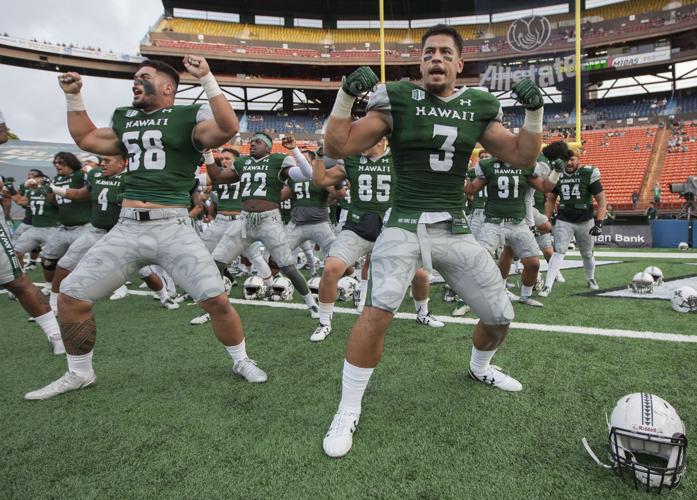During the rise of Arizona’s Desert Swarm and Tedy Bruschi’s Hall of Fame career, someone asked Dick Tomey if he had ever seen anything like No. 68.
In his tactful manner, Tomey said, “Well, I coached Al Noga, Rich Miano and a bunch of good players at Hawaii, but Tedy’s right up there.”
Touché.
Before Tomey moved to Tucson, the Hawaii Rainbows were up, up and away. (Note to millennials: That’s an epic 5th Dimension song from the golden era of Hawaii football.)
The Rainbows were one of the toughest outs in college football from 1980 to 2010. In the Tomey years, they used every available seat at Aloha Stadium, all 50,000, for madhouse showdowns against Michigan, Iowa and especially BYU. They were the only team to blacken Fresno State’s 11-0-1 season of 1985.
Last year, Hawaii averaged 23,433, and that total was surely padded.
So much has changed.
Since Rich Rodriguez began coaching Arizona, the least successful FBS teams are:
Kansas, 42 losses
Eastern Michigan, 42 losses
Hawaii, 41 losses
The Rainbows have hired and fired three athletic directors since 2008. They were forced to move $14 million in accumulated debt from the athletic department to the school’s general account. One of the fired ADs, Ben Jay, struck panic in 2014 when he said, “There’s a real possibility of football going away.”
Over the last 15 games, Hawaii’s only victories have come against Tennessee-Martin, Louisiana-Monroe and UC Davis.
Here’s a hyphen for you: In the state of Hawaii’s top-10 high school recruiting classes of 2015 and 2016, the Rainbows kept just one of the 20 leading prospects. Last year, Arizona got the No. 1 overall Hawaiian, offensive lineman Michael Eletise. Vanderbilt got No. 3. Central Florida got No. 9. A year earlier (2015) the Rainbows — they’re technically the Rainbow Warriors now — were unable to keep any of the 10 leading Hawaiian recruits. But Texas Tech, San Diego State and Oregon State each got one.
So when the Rainbows arrive at Arizona Stadium for Saturday’s game, you won’t be seeing your grandfather’s, or Dick Tomey’s, Hawaii football team.
Incredibly, Oregon State has six starters from Hawaii or Samoa, and Washington State five. That turf used to be ruled by Tomey and his Rainbow successors Bob Wagner and June Jones.
Now it belongs to the Pac-12. Conference teams have 44 Hawaiians or Samoans on their rosters this season, including seven Oregon Ducks and Arizona senior defensive linemen Sani Fuimaono and Aiulua Fanene.
When Tomey was introduced as Arizona’s coach in January 1987, he spoke with heart about his admiration for Hawaii, its players and fans. He flew back to Honolulu a day later and told me he had second thoughts about actually following through and returning to Tucson.
“We’ve built so much and done so well,” he said. “I wasn’t sure I wanted to give that up.”
One of Tomey’s strengths at Hawaii was his ability to recruit and develop Polynesian players and embrace the culture.
He could correctly pronounce every syllable of the most famous Hawaiian athlete ever, gold medal swimmer Duke Kahanamoku, and throw in 1930s UH All-America football player Thomas Kaulukukui without a hitch.
And he still can.
Tomey was able to stop much of the exodus of Hawaii’s best players and future NFL standouts, such as Russ Francis to Oregon and Mosi Tatupu to USC. With it came the rise of Rainbows football behind, among others, Miano, Jesse Sapolu, Nuu Faaola, Ma’a Tanuvasa and especially the statuesque Noga brothers, Al, Pete and Falaniko.
Here’s how much things have changed at Hawaii: Its starting cornerback is Jalen Rogers, a Cienega High School product who spent two years at Mesa College before becoming a Hawaii regular.
Now the Rainbows are recruiting Tucson. It seems so odd.
Even Tomey had difficulty pulling Polynesian players out of Hawaii in his first five Arizona seasons. From 1987 to 1991, his only Hawaiian player was guard Nick Fineanganofo, and that was during a period in which Tomey’s coaching staff was stocked with ex-Hawaii coaches Duane Akina, Larry Mac Duff, Dave Fagg and Sam Papalii.
But once Desert Swarm became a national brand, Tomey went back to the islands and scored heavily.
In 1998 and 1999 alone, the UA deployed Makai Freitas, his brother Makoa Freitas, Steven Grace, Keoni Fraser, Ben Alualu, Joe Siofele, Ben Tuinei, Young Thompson and Manuia Savea.
The UA won 18 games in those two seasons. By then, every Pac-12 team began to recruit Hawaii and Samoa with more diligence.
Two of the best players at No. 8 Washington, lineman Shane Brostek and linebacker Psalm Wooching, are from Honolulu.
Brostek? Does that ring a bell?
His dad, Bern Brostek, head football coach at Hawaii Prep Academy, is the brother of former UA lineman Ari Brostek, a former Tomey recruit.
It takes forever to fly from Pac-12 territory to Honolulu, but in college football it has become a frequent flier route.






